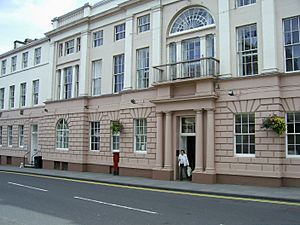County Buildings, Cupar facts for kids
Quick facts for kids County Buildings, Cupar |
|
|---|---|

County Buildings, Cupar
|
|
| Location | St Catherine Street, Cupar |
| Built | 1817 |
| Architect | Robert Hutchison |
| Architectural style(s) | Neoclassical style |
|
Listed Building – Category B
|
|
| Official name: County Buildings and former Court House, excluding 4-storey offices and police station adjoining to rear and single storey block to east, St Catherine Street, Cupar | |
| Designated | 1 February 1972 |
| Reference no. | LB24160 |
| Lua error in Module:Location_map at line 420: attempt to index field 'wikibase' (a nil value). | |
County Buildings is an important old building in Cupar, Fife, Scotland. It's on St Catherine Street. This building used to be where the local government, called Fife County Council, met. It's also a special "Category B" listed building, meaning it's protected because of its history and architecture.
Contents
History of the Building
Building a New Street
A long time ago, in the early 1800s, the leader of Cupar, named John Ferguson, had a big idea. He wanted to knock down some old buildings, like the old jail (called a tolbooth) and a house nearby. His plan was to create a brand new street. Along this new street, there would be important public buildings. These included the new town hall (called burgh chambers) and, a bit further along, the County Buildings and the local court.
Design and Style
The new County Buildings were designed by an architect named Robert Hutchison. He used a style called neoclassical, which was popular at the time. This style often looks like old Greek or Roman buildings. The building was made from cut stone, called ashlar, and then covered with a smooth, plaster-like finish called stucco. The construction was finished in 1817.
Inside the County Buildings
The building's main front faces St Catherine Street and has many windows. The middle part of the building has a main door with tall, fancy columns. Above the door, there's a balcony. On the first floor, there are large windows. Inside, the most important rooms were the council chamber, where meetings were held, and the courtroom, where legal cases were heard.
Changes Over Time
For many years in the 1800s, the building was mainly used as a court. It was a place where justice was carried out. Later, in 1889, a new law was passed in Scotland. This law created county councils in every area. Because of this, the County Buildings also became the main offices for Fife County Council.
As the county council grew and needed more space, another part was added to the building. This new section was built in 1925 by architects Thoms and Wilkie. It matched the style of the original building but didn't have the stucco finish.
New Councils and Uses
In 1975, the county council was closed down. The building then became the offices for a new local government group called North East Fife District Council. For a short time, it was shared with Fife Regional Council. However, that council soon moved to a new building called Fife House in Glenrothes.
North-East Fife District Council was also closed in 1996. After that, Fife Council became the main local government for the whole area. Their main office is in Glenrothes. Since then, the County Buildings in Cupar have been used as a customer service centre for Fife Council. This means local people can go there for help and information.
Art in the Building
The County Buildings also hold some interesting works of art. These include portraits of important historical figures. You can see a painting of King George II by John Shackleton. There's also a portrait of King George III by an artist whose name we don't know. Another painting shows Queen Charlotte by Allan Ramsay.
Other portraits include:
- John Hope, 4th Earl of Hopetoun by Henry Raeburn
- James Bruce, 8th Earl of Elgin by Francis Grant
- Thomas Erskine, 9th Earl of Kellie by David Wilkie
- Sir Ralph William Anstruther, 6th Baronet by Sir William Llewellyn
See also
- List of listed buildings in Cupar, Fife

